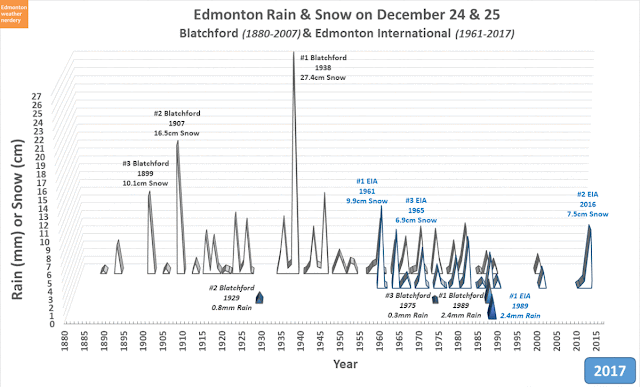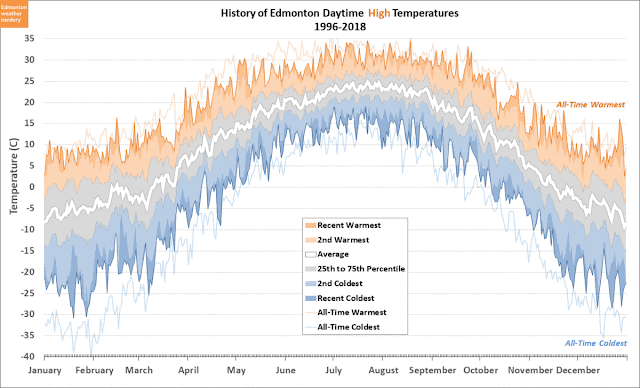The title of today's post is not great, but we're going to be looking at how the temperatures for each month of the year have changed since records began. And thus: "The Months through the Years."
It goes back to this chart, which we saw last month in the
October Review / November Preview:
There are quite a few things going on here:
- The average Daily Mean temperatures (average of the Highs & Lows) for each October are the orange & blue bars. October 2018 ranked as the 92nd warmest since 1880.
- The average Daily Low temperatures are the blue line - 2018 ranked 86th.
- The average Daily High temperatures are the orange line - 2018 ranked 89th.
At the end of this animation the 10-Year Averages for the Low, Mean, and High appear as dotted, red lines. Those averages show how temperatures have changed over time, and they are what we're going to be talking about today. For October the average Low has risen from about -2°C to +1°C, but the average High has actually fallen from 12°C to 10°C. That last part seems weird.
Let's get started with a quick recap of Edmonton's temperature history:
Warm Years
We use this chart
quite often. It shows how the average temperature for each year compares to the 20th century average. Back in the 1880s the temperatures here were 1°C or 2°C colder than the 20th century average, but since about 1975 most of our years have been 1°C or 2°C warmer than the 20th century average.
The numbers in this chart are for an entire year - they are the average of the Highs & Lows for all 365.25 days. But when we break that down a bit we will see that some parts of the year have changed more than others.
Warm Months
We've used this chart
in the past too, and it shows how warm each month is, compared to the 20th century average for that month. This lets us see 20 years at a time, and over on the far right is the average for those 20 years. As this animation cycles through from the 1880's to today we can see how that average has changed from colder (blue) to warm (orange).
To make things simpler, here is the first slide of that animation which covers 1880-1899.
130+ years ago there were some warm months - notably January 1889 was 8°C warmer than the 20th century average, and November 1890 was 7°C above. But there were also some really cold months, with December 1880, January 1886, February 1887, and November 1896 averaging 11-14°C below the 20th century average.
When we look at the "20-Year Average Difference" column on the far right we can see that for this time period all twelve months of the year were below the 20th century average. January & February were the most below at -2.3°C and -3.1°C, whereas April & December were both only a little bit below at -0.3°C.
And in comparison here we have 1999-2018. There are still some blue bubbles here for cold months, with the most below-average month being March 2002 at -7°C. But just generally there is a lot more orange on this chart than what we saw for 1880-1899.
Looking at the "20-Year Average Difference" again:
- The late-winter months of January & February have seen big changes in recent years, averaging 4.3°C and 2.4°C warmer than their 20th century average.
- The early-winter months of November & December are only 1°C and 1.2°C warmer, which is about the same change that the summer months of June-September have seen.
- The shoulder-season months of April & October have actually been a little bit cooler than the 20th century average.
Even with plenty of variation year-to-year and month-to-month, January and February are where we've seen the most consistent and the largest changes. From the 1880's to today January's average temperature has increased by 6.6°C and February's has increased by 5.5°C. The next largest is March with only a 2.3°C change.
For this chart we are using the Monthly average of the Daily Mean temperature, which is the average of the Daily Highs & Lows. Next we are going to split the Highs & Lows up to see how they behave separately.
Monthly Lows
This chart cycles through the average Low temperature for each month of the year, with the history going back to 1880. The dotted red line is a standard best-fit trendline.
For all 12 months of the year the Low temperatures are trending upwards, although there is a lot of variation:
Monthly Average Low
Temperatures
|
|
|
|
|
|
1880s
|
2010s
|
Change/Century
|
January
|
-21°C
|
-15°C
|
5.3°C
|
February
|
-19°C
|
-12°C
|
5.5°C
|
March
|
-12°C
|
-7°C
|
3.8°C
|
April
|
-3°C
|
0°C
|
1.7°C
|
May
|
3°C
|
6°C
|
2.5°C
|
June
|
7°C
|
11°C
|
3.2°C
|
July
|
9°C
|
13°C
|
3.3°C
|
August
|
8°C
|
12°C
|
3.3°C
|
September
|
3°C
|
7°C
|
3.1°C
|
October
|
-2°C
|
1°C
|
1.9°C
|
November
|
-10°C
|
-7°C
|
1.8°C
|
December
|
-16°C
|
-13°C
|
1.5°C
|
We don't normally use tables at Edmonton Weather Nerdery, but it's probably the easiest way to talk about this.
The Lows for January & February have changed a lot, trending upwards at more than 5°C per 100 years. March and the summer months have all increased at around the 3°C range. And then April and October-November have been more sedate, averaging 1.5°C-1.9°C per century.
The slopes of the various trendlines in this chart really make the differences between the months apparent. But normally we try not to use trendlines, because they imply that you can extrapolate into the future, even if that might not be appropriate. As an alternative to the trendlines, here is a different approach:
This chart is not as pretty unfortunately, but this uses the 10-Year average Low for each month instead of trendlines.
It tells a similar story to what we just saw above, albeit this time in a more wobbly fashion: January & February have increased a lot, May-September have a visible upward trend, and the rest of the months are a little flat-ish.
We've looked at the Daily Mean temperatures and the Daily Low temperatures, and so now all that's left is:
Monthly Highs
In this chart we've moved on from the Lows to the Highs, and the thing to notice here is that not all of the trendlines are sloped upwards:
Monthly Average High Temperatures
|
|
|
|
|
|
1880s
|
2010s
|
Change/Century
|
January
|
-10°C
|
-6°C
|
3.1°C
|
February
|
-7°C
|
-3°C
|
3.0°C
|
March
|
1°C
|
1°C
|
0.3°C
|
April
|
11°C
|
10°C
|
-1.0°C
|
May
|
18°C
|
18°C
|
-0.3°C
|
June
|
21°C
|
21°C
|
0°C
|
July
|
23°C
|
23°C
|
0.1°C
|
August
|
22°C
|
22°C
|
0.3°C
|
September
|
17°C
|
17°C
|
0.3°C
|
October
|
11°C
|
10°C
|
-0.7°C
|
November
|
1°C
|
1°C
|
-0.3°C
|
December
|
-6°C
|
-6°C
|
0.1°C
|
Again, January & February have had the biggest changes with average High temperatures increasing by about 3°C per century. The summer months have also trended upwards a little bit. But for the shoulder-season months the average Highs have actually fallen by -1°C for April and -0.7°C for October.
(if you've noticed that the numbers in these two tables don't add up to the bubblechart that we started with, there are two reasons for that: 1) the bubblechart used a 20-Year window while the tables use 10-Years; and 2) the tables use the best-fit line which isn't a perfect match to the measured data.)
Switching from trendlines to 10-Year averages again:
And this is similar again, with the Highs for January & February noticeably increasing, while the rest of the months look pretty flat.
The Yearly Rollercoaster
This is another way to look at things.
In this chart the blue and orange background is the range of our yearly Low temperature rollercoaster, for 1996-2018. The white line running through the middle is the recent average Low for each day of the year. The red line that appears is the average Low for 1880-1899.
For almost the entire year the red 1880-1899 line is shifted down from the white recent line, with really large gaps in late-January, early-February, and late-November. But for a few parts of the year - early-March, mid-April, late-November and early-December - the historic average Lows are very close to modern temperatures.
When we switch this chart to compare 1880-1899 average Highs the differences are less clear.
Again, there is a big gap between the red & white lines in late-January and early-February, where the High temperatures today really are 5°C warmer than they used to be. But for the rest of the year the lines are very close to one another. In April the lines look about even, but for October the red historic line is noticeably above the white modern line.
The Shoulder Season
So lets take a closer look at April & October:
April
October
With both April & October the Lows have increased by about as much as the Highs have decreased.
Those two months have something else in common:
On the yearly temperature rollercoaster April and October are mirror-images of each other. They are the two months where the temperatures are changing the fastest - from winter into spring, and from fall into winter.
But why have the average Highs nudged down over the years? No idea. That's outside the scope of mere weather nerdery, and it would need to be left to the real climate scientists out there.
December vs. January
We're going to finish today by taking a look at two neighbouring months who haven't been following the same path.
December
December's temperatures haven't changed very much over they years. The average Daily mean has hovered around -10°C, with the average High around -6°C or -7°C, and the average Low warming up a bit from -16°C to around -13°C.
January
January is a different story, with the Highs, the Lows, and the resulting Daily Means all jumping up by more than 5°C.
And that means that January is no longer Edmonton's coldest month:
January used to be Edmonton's coldest month by far, with average Highs 5°C colder than February & December, and Lows 4°C below February and 5°C below December.
But because in recent year January & February have both warmed up so much they've passed December, putting it in coldest-spot for both Highs & Lows. The fact that our winter bottoms-out in December is something that we saw in
Are we there (the middle of winter) yet?
Summary
In previous posts we have seen that Edmonton's recorded temperatures have been warmer recently than they were a century ago. We've also looked at
nearby rural stations and to
other Canadian cities, and have seen a similar pattern.
When we dig deeper into Edmonton's temperatures we see that the changes have been concentrated in January & February, with large increases in both the Highs and the Lows. The summer months and November & December have seen small increases to the average Lows, but the average Highs have been relatively unchanged. And for the shoulder-season months of April & October the average Lows have also increased a bit, but that has been offset by a decrease in the average Highs for those months.
And in general all of that goes back to something that we saw in
one of Edmonton Weather Nerdery's earliest posts: Edmonton might not be getting much warmer, but it has been getting less cold.






















































